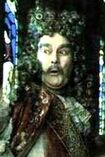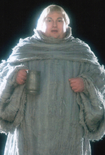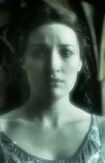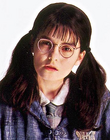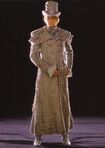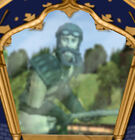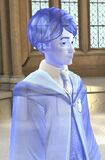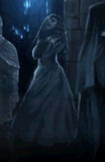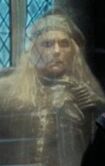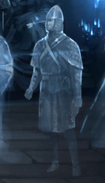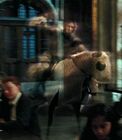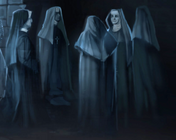
|
Warning!
At least some content in this article is derived from information featured in: Harry Potter: Wizards Unite & Harry Potter: Hogwarts Mystery. |
- "A ghost, as I trust that you are all aware by now, is the imprint of a departed soul left upon the earth..."
- — Professor Severus Snape[src]
A ghost is the imprint of the soul of a once-living wizard or witch, and as such, a type of spirit. These fleshless spirits are either afraid of death or have some extraordinarily strong connection to the locations they haunt.
Ghosts are unable to have much physical influence. They are visible, and appear as a greyish-silver apparition of their former (living) selves. They pass through solid objects without damaging themselves or the material, but create disturbances in water, fire and air. The temperature drops in the immediate vicinity of a ghost. Their presence can also turn flames blue.[1]
Non-magic people cannot become ghosts, nor can they see ghosts clearly.[1]
In some instances, animals may also become ghosts upon death.[2]
Nature
- "Wizards can leave an imprint of themselves upon the earth, to walk palely where their living selves once trod... But very few wizards choose that path."
- — Sir Nicholas discussing ghosts with Harry Potter[src]
A ghost is the transparent, three-dimensional imprint of a deceased witch or wizard, which continues to exist in the mortal world. Muggles cannot come back as ghosts, and the wisest witches and wizards choose not to.[1] It is those with 'unfinished business', whether in the form of fear, guilt, regrets or overt attachment to the material world who refuse to move on to the next dimension.[1]As a result, ghosts know nothing about the afterlife and some later come to regret that they became ghosts instead of moving on.
Having chosen a feeble simulacrum of mortal life, ghosts are limited in what they can experience. No physical pleasure remains to them, and their knowledge and outlook remains at the level it had attained during life, so that old resentments (for instance, at having an incompletely severed neck) continue to rankle after several centuries.[1] For this reason, ghosts tend to be poor company, on the whole. They are especially disappointing on the one subject that fascinates most people: ghosts cannot return a very sensible answer on what it is like to die, because they have chosen an impoverished version of life instead.[1]
Depending on the conditions of the person's soul, they may not be able to return, as Tom Riddle's self-mutilated soul is trapped in limbo for eternity and cannot become a ghost.[3]
Abilities
In passing through a living creature, ghosts give the sensation of plunging into ice-cold water.[4] Ghosts also secrete ectoplasm over time in places that they frequent.[5] They also have the ability to "almost" taste food, which is amplified with the use of pungent, rotting food.[6]
In addition, ghosts are also weightless and may fly in any direction. Ghosts are also able to be moved by the currents of air and water.[7][8]Ghosts cannot be destroyed (as they are already dead), however, they may be petrified with the gaze of a Basilisk. This can be reversed by a Mandrake Restorative Draught, although the method of administration is unclear. Ghosts may also be repelled by magical light, and therefore will retreat from a Wand-Lighting Charm.[9][5] Ghosts can also be frightened and retreat from a Skurge Charm, which will also clean up any ectoplasm that they have precipitated.[5]
Ghosts are known for gravitating around a specific area, often the location of their death. In such a case, it is said that the ghost "haunts" that location. They appear to have a particular connection to that location, as it is apparently possible to bind them there magically.[10] It is possible that ghosts may be bound into a mirror, producing an item known as a haunted mirror.
Ghosts in the wizarding world
Witches and wizards are much more susceptible to what Muggles call paranormal activity, and will see (and hear) ghosts plainly where a Muggle might only feel that a haunted place is cold or 'creepy'.[1] Muggles who insist that they see ghosts in perfect focus are either a) lying or b) wizards showing off — and in flagrant breach of the International Statute of Secrecy.[1]
The Ministry of Magic seems to have at least a degree of power and jurisdiction over ghosts, as Moaning Myrtle was forced to return to her place of death, which was Hogwarts School of Witchcraft and Wizardry, when she disrupted the wedding of the brother of Olive Hornby.[11] The Spirit Division is the division of the Department for the Regulation and Control of Magical Creatures deals with ghost welfare.[12][13]
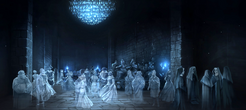
Nearly Headless Nick's deathday party
Ghosts also appear to celebrate their deathday, as Nearly Headless Nick did so on 31 October in 1992. They tend to be very sensitive concerning the circumstances of their death, often showing great hesitancy when asked by others how they died. What seems to be a typical deathday Party entails a candlelit dinner of rancid, mouldy food, the smell of which would cause a normal living creature to gag. The only people normally invited to a deathday party are no longer living.[6]
House ghosts
- "About twenty ghosts had just streamed through the back wall. Pearly-white and slightly transparent, they glided across the room talking to one another and hardly glancing at the first years."
- — Harry's first experience viewing ghosts at Hogwarts.[src]
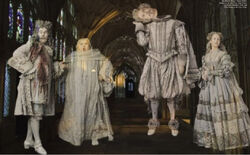
Hogwarts ghosts (left to right): Slytherin House Ghost, Bloody Baron; Hufflepuff House Ghost, Fat Friar; Gryffindor House Ghost, Sir Nicholas de Mimsy-Porpington; Ravenclaw House Ghost, Helena Ravenclaw
Many ghosts take up residence within Hogwarts Castle and each House at Hogwarts has a patron ghost. Each of these ghosts once belonged to their corresponding House. They apparently serve as a representative to their House, as well as serving the role of messenger or guide to those who are still unfamiliar with the House they were sorted into.[14][4] It is unknown for how long they may retain this title.
They also seemed to enjoy a certain level of authority, as Sir Nicholas de Mimsy-Porpington apparently outranked the Caretaker at the school, bidding Argus Filch to award a student ten house points before ordering him to leave the Potions Classroom, where they were caught snooping while, unbeknownst to Filch, researching the Cursed Vaults despite not being allowed to.[15]
Gryffindor House
- "I know nothing of the secrets of death, Harry, for I chose my feeble imitation of life instead..."
- — Sir Nicholas
The Gryffindor House ghost is Nearly Headless Nick. He is known as a friendly ghost who was nearly beheaded, but the job was poorly executed, which was how he obtained the nickname of "Nearly Headless Nick". He prefers to be addressed as "Sir Nicholas". His real name is Sir Nicholas De Mimsy-Porpington. Something of a snob, and a less accomplished wizard than he believed, Sir Nicholas lounged around the court of Henry VII in life.[14]
Hufflepuff House
The Hufflepuff House is haunted by the Fat Friar, who was executed because senior churchmen grew suspicious of his ability to cure the pox merely by poking peasants with a stick, and his ill-advised habit of pulling rabbits out of the communion cup. Though a genial character in general, the Fat Friar still resents the fact that he was never made a cardinal.[14] He also frequently suggests that Peeves should have a second chance, whether or not he deserves it.
Ravenclaw House
The Ravenclaw House ghost is the Grey Lady, also known as Helena Ravenclaw. The least talkative of the house ghosts, she is long-haired and beautiful.[14] She was the daughter of Rowena Ravenclaw, making her the only house ghost to be directly related to one of the four Hogwarts founders. She was murdered by the man now known as the Bloody Baron in a rage. She is renowned for being instrumental in assisting Harry Potter in the search for the Horcruxes.[16]
Slytherin House
The Slytherin House ghost is the Bloody Baron. He is well known for being extremely unsocial and many students, including those of his own House, are known to be slightly afraid of him.[14] The Baron is also the only one known to be able to control Peeves. The Bloody Baron committed suicide out of remorse for murdering Helena Ravenclaw in a rage, and was known for having a highly volatile temper when he was alive.[16]
Known ghosts
- Ragged man wearing chains
- Portly ghost
- Horatio Cloke
- Unidentified ghost (VII)
- Unidentified ghost horse (II)
See also
Behind the scenes
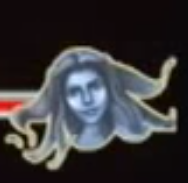
- In the video game Harry Potter: Quidditch World Cup, a ghost named Edgar Clogg haunts the Quidditch pitch and provides coaching.
- Professor Amberose Swott may have become a ghost after death as he appears in a portrait at Hogwarts, but also on the Marauder's Map.
- According to W.O.M.B.A.T., ghosts may have the ability to move liquid or gas.
- The ghosts Edmund Grubb, the Black Knight and The Toad were cut from final drafts.[17]
- It is possible that while ghosts might be silver-greyish to the living, it is possible that through their eyes, they see themselves and each other the way they looked alive, as Nearly Headless Nick was able to read a Ghost letter that appeared to be transparent to Harry, meaning that he could not see any written text on it, even if Sir Nicholas could.
- Although murder rips the soul, true remorse can heal it again. One example would be the case of The Bloody Baron as he killed Helena Ravenclaw, but felt remorse over her death, thus he was able to come back as a ghost.
- The house ghosts are known to have died in different time periods. The Grey Lady and the Bloody Baron both died shortly after the founding of Hogwarts. Sir Nicholas died in 1492. The Friar also died in the founders' time. Thus, it's not known at which point in Hogwarts history the house ghost position was created or if other ghosts ever held this title.
- On Pottermore, there is a feature called "The 6 best-loved ghosts (and one poltergeist) at Hogwarts."
- According to Rubeus Hagrid, many ghosts like lily flowers.
- According toPottermore, ghosts exist worldwide. Most ghosts reside in Great Britain. And the most haunted place in Great Britain is Hogwarts Castle.
- The presence of a ghost turns flames blue, according to Pottermore. Normally, a blue flame is the hottest variety of fire. Ghosts are, however, described as making the environment cold, possibly meaning the flames they influence turn cold as well.
- Unlike other ghosts in the films, the Grey Lady is able to turn into an wispy ball of light. Also, while other ghosts where white or blue in colour while being otherwise transparent, she was grey and shadows could be cast over her. She is one of the few ghosts seen walking on the ground rather than simply flying.
- It is unknown if the House ghost position also exists at other wizarding schools.
Author's comments
"The inspiration for Moaning Myrtle was the frequent presence of a crying girl in communal bathrooms, especially at the parties and discos of my youth. This does not seem to happen in male bathrooms, so I enjoyed placing Harry and Ron in such uncomfortable and unfamiliar territory in Harry Potter and the Chamber of Secrets and Harry Potter and the Half-Blood Prince.
The most productive ghost at Hogwarts is, of course, Professor Binns, the old History of Magic teacher who fell asleep in front of the staff-room fire one day and simply got up to give his next class, leaving his body behind. There is some debate as to whether or not Professor Binns realises he is dead. While his entrance to lessons through the blackboard is vaguely amusing the first time students see it, he is not the most stimulating teacher.
The inspiration for Professor Binns was an old professor at my university, who gave every lecture with his eyes closed, rocking backwards and forwards slightly on his toes. While he was a brilliant man, who disgorged an immense amount of valuable information at every lecture, his disconnect with his students was total. Professor Binns is only dimly aware of his living students, and is astonished when they begin asking him questions.
In the very earliest list of ghosts I ever wrote for Hogwarts, I included Myrtle (initially named 'Wailing Wanda'), Professor Binns, the Grey Lady (then called 'the Whispering Lady') and the Bloody Baron. There was also a Black Knight, The Toad (which left ectoplasm all over its classroom), and a ghost I rather regret not using: his name was Edmund Grubb, and the notes beside his name say: Expired in the doorway of the Dining Hall. Sometimes stops people getting in, out of spite. Fat Victorian ghost. (Ate poisonous berries)."
Appearances
- Harry Potter and the Philosopher's Stone (First appearance)
- Harry Potter and the Philosopher's Stone (film)
- Harry Potter and the Philosopher's Stone (video game)
- Harry Potter and the Chamber of Secrets
- Harry Potter and the Chamber of Secrets (film)
- Harry Potter and the Chamber of Secrets (video game)
- Harry Potter and the Prisoner of Azkaban
- Harry Potter and the Prisoner of Azkaban (film)
- Harry Potter and the Goblet of Fire
- Harry Potter and the Goblet of Fire (film)
- Harry Potter and the Order of the Phoenix
- Harry Potter and the Order of the Phoenix (video game)
- Harry Potter and the Half-Blood Prince
- Harry Potter and the Half-Blood Prince (video game)
- Harry Potter and the Deathly Hallows
- Harry Potter and the Deathly Hallows: Part 2
- LEGO Harry Potter: Years 1-4
- LEGO Harry Potter: Years 5-7
- Harry Potter: Quidditch World Cup
- Pottermore
- Harry Potter: The Character Vault
- Harry Potter: Hogwarts Mystery
- Harry Potter: Wizards Unite
- Harry Potter: The Wand Collection (Mentioned only)
External links
Ghost on Wikipedia
Poltergeist on Wikipedia
Notes and references
- ↑ 1.0 1.1 1.2 1.3 1.4 1.5 1.6 1.7 Writing by J. K. Rowling: "Ghosts" at Wizarding World
- ↑ Pottermore- Animal Ghosts of Britain
- ↑ Harry Potter and the Deathly Hallows, Chapter 35 (King's Cross)
- ↑ 4.0 4.1 Harry Potter and the Philosopher's Stone, Chapter 7 (The Sorting Hat)
- ↑ 5.0 5.1 5.2 Harry Potter and the Chamber of Secrets (video game)
- ↑ 6.0 6.1 Harry Potter and the Chamber of Secrets, Chapter 8 (The Deathday Party)
- ↑ Harry Potter and the Chamber of Secrets, Chapter 11 (The Duelling Club)
- ↑ Harry Potter and the Goblet of Fire, Chapter 26 (The Second Task)
- ↑ Harry Potter and the Philosopher's Stone (video game)
- ↑ Such was apparently done to Myrtle Warren in the 1940's, although it is plausible that she was simply coerced by other means into staying in the bathroom in question.
- ↑ Harry Potter and the Goblet of Fire, Chapter 25 (The Egg and the Eye)
- ↑ Fantastic Beasts and Where to Find Them
- ↑ Harry Potter and the Order of the Phoenix, Chapter 7 (The Ministry of Magic)
- ↑ 14.0 14.1 14.2 14.3 14.4 Writing by J. K. Rowling: "Hogwarts Ghosts" at Wizarding World
- ↑ Harry Potter: Hogwarts Mystery
- ↑ 16.0 16.1 Harry Potter and the Deathly Hallows, Chapter 29 (The Lost Diadem)
- ↑ Writing by J. K. Rowling: "Hogwarts Ghosts" at Wizarding World

